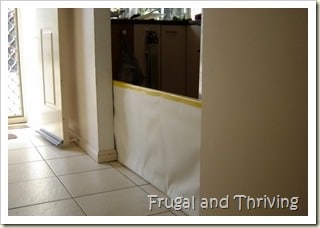surviving the ‘just in case i need it’ gene–balancing frugality and clutter
This website may earn commissions from purchases made through links in this post.

“I thought you might be able to make something with this,” he explained.
Several thoughts flashed through my mind:
How am I going to reuse this blind?
Where am I going to put this blind in the meantime?
Hmmm, my penchant for keeping junk is rubbing off on DH.
This blind looked brand new. Apart from the broken retraction mechanism, it was in perfect condition. Such a shame for it to be thrown in the bin.
So I stashed it in the downstairs toilet along with:
- Seven empty vinegar bottles
- Two bags of empty toilet rolls
- A roll of old carpet
- Half a bag of cement
- a bag of 10 year old tax returns and bank statements that I had yet to shred
- a mattock
- a box of out-of-date vegetable seeds
- a bucket full of bibs and wipes, soaking
Somewhere in there, there’s also a toilet.
Despite the fact that we buy less ‘stuff’ than your average Joe, and despite the fact that I find myself decluttering constantly, we do struggle with clutter.
Just a little bit.
A lot of the stuff that clutters our house is ‘just in case’. The bag of bubble wrap – just in case I need to send something. The egg cartons – just in case they come in handy for kid’s craft. The jars – just in case I need them for storage (actually, I never seem to have enough jars). The used gift wrap, the empty toiletry bottles, the old, torn clothing…
Reuse, repurpose, recycle: that’s part of the frugal way of life. But at what point does repurposing become hoarding and the clutter hinder your attempts at simplifying life?
The answer to that question will be different for each of us.
Here are four ways that I’ve found help bring balance between hoarding things ‘just in case’ you need them and keeping the clutter at bay.
1. Set limits
Two or three egg cartons kept for impromptu craft or seedling planting is probably enough. Twenty or thirty becomes a hoarding issue, unless you have a specific purpose for them and you know you will use them.
In the near future.
Be firm (if the hoarding voice is loud and strong) and limit yourself to collecting just a couple of things and recycle or donate the rest.
Use space to limit your collecting too. Once your gift wrap box is full, then it’s time to stop collecting used gift wrap and start reusing what you have.
2. Have a place for everything and everything in it’s place
A little bit of hoarding can be beneficial, but collections of junk soon get out of hand if it’s not organised. A ‘junk box’ for recycled items that can be used in kid’s craft is contained and tidy – a landslide of empty cartons and containers every time you open the dunny door is not so ideal.
3. Have and end use in mind
I’m the first to admit to breaking this rule – the blind is a good example. And things that we’ve kept for no reason have come in handy.
Eventually.
But you’ve got to be ok with the clutter if you break this rule.
And every six months or so I’m not ok with the clutter and it’s this kind of stuff that get’s cleared out (see rule number four).
Because if you harbour vague notions along the lines of ‘this might come in handy someday’, then it’s more than likely that you wont use it someday.
4. Use it or lose it
So, you’ve got a very good reason for holding onto whatever junk it is you’re hoarding. It’s just the thing for that project you’ve been moodling over.
And eighteen months later, it’s still sitting there, waiting for you to start, and you can’t quite remember what it was you had in mind.
At some point you have to be honest with yourself about whether you’re really going to make use of what you’ve collected. Or whether you’re better off giving it away and allowing someone else to make use of it.
Stuff sitting in cupboards for years is wasted. Set it free and allow it to fulfil its usefulness.
We did actually use the blind that DH rescued.
Not as it was originally intended, instead we cut the fabric part off and used it to build a sliding baby gate for the kitchen.

The gate is sturdy, does the job and was free – the blind being stapled (and taped) to a frame made from scrap wood. Because the blind is plastic, the rest will make an excellent drop cloth under the high chair or art table. And I’m sure it will be reused in other ways as well.
There’s nothing wrong with having the ‘keep it just in case’ gene. Repurposing is a frugal art form. But it needs to be tempered with a certain amount of restraint, lest your stuff takes a hold and clutters up your life.





Having an end use in mind is the rule that I use :-) I find living in a tiny flat is also a pretty good way to cut down on clutter – if there’s no space for it, there’s just no space!
A very good set of rules to adhere to. I will be showing this to my husband. He is the reason I can never have a fully clean house and garage lol
You’re not the only one Jenize! We don’t park the car in the garage because there is so much ‘stuff’ in there!
Gosh! You just gave me a fabulous idea for using old rubber backed curtains to create a baby barrier…it will look so much better than the de-constructed packing boxes we’ve been using for the past year. Thanks!!
I grew up with “Just in case” and “save it for good”.
As a result I hold onto things in case I need them, but then I don’t use them as I might deem the project “not good enough”. Honestly stupid of me, I am better at letting now, but it can be hard to let the girls trash a shoe box.
I can so relate to this! I do exactly the same thing!!